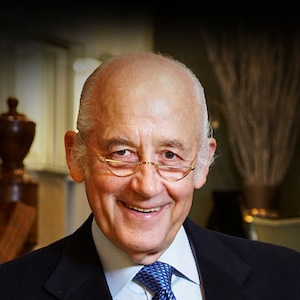
Henry Dunay, who was one of the first jewelry designers to promote their name to the general public, died on Nov. 10. He was 88.
Considered one of the two “founding fathers of American jewelry design” (Jose Hess was the other), Dunay was born Henry Loniewski in Jersey City, N.J. His father was a tugboat captain and his mother a factory worker.
At age 14, he began working as an errand boy and apprentice for New York City jeweler Rudolph Cacioli and caught the jewelry bug. “By 18, I had a clear sense of who I wanted to be,” he said in 2013.
In 1956, at age 21, he founded his own company. He adopted his mother’s maiden name because “it’s five letters. You figure everyone will remember a five-letter name,” he said.
Dunay’s jewelry looks were often big and bold. His signature became the Sabi finish, a scratched surface technique influenced by the Japanese tradition of wabi-sabi.
“He was one of the few jewelry designers with an identifiable aesthetic, who made his name known to high-end American collectors,” says industry journalist Jennifer Heebner. “He exhibited at Baselworld at a time when few Americans did, and gained an international reputation for sophisticated design that was coveted by high-end collectors.”
Dunay’s career got a big boost in 1967 when he received a De Beers Diamonds International Award. He’d go on to win three more. Other highlights included creating the Cynnabar ring—with an Arkansas diamond—that Hillary Clinton wore to her husband’s first inaugural in 1993 and the famous Lachrymosa diamond mask that Elizabeth Taylor modeled prior to its 1992 auction at Christie’s to benefit an AIDS charity.
In 1988, Dunay cofounded and became the first president of the American Jewelry Design Council. A biography, Henry Dunay: A Precious Life, by Marion Fasel and Penny Proddow, was published in 2007.
Dunay once said his work was “inspired by my curiosity. If I don’t know how to do something, I’ll just go out and learn it.”
For all its highs, Dunay’s career also suffered some lows. In 2009, his company filed for Chapter 11 and eventually closed. He resumed designing the next year, but soon ran into a nasty legal fight: His company’s intellectual property had been purchased in the bankruptcy proceedings, so there were strict limitations on how Dunay could use his name. At the time, he told JCK that this trip through the court system was “worse than the bankruptcy. I just want this to be over with, so they can let me do what I do best.”
He had no doubt what that was. “I am not a golfer, I am not a tennis player. I make jewelry,” he said in 2009. A year earlier, he discussed why he stayed dedicated to his craft: “You sell jewelry, but that moment when the customer falls in love and you see it in her face, that’s the payment, that’s the joy of what I do.”
Among the many people paying tribute to Dunay on Facebook was writer Roberta Naas: “I am so proud to own of some Henry’s jewels but I am way happier to have known him. Kind, creative, and incredibly charismatic, Henry may have been one of the most prolific and innovative designers of his time.”
Jeweler Gerald Riveron posted: “Henry Dunay was an extraordinary jewelry designer…. To all those who own a piece of jewelry made by Henry, please wear his jewelry as often as you can and feel fortunate to have acquired his pieces. The legacy of his work confirms that jewelry is art.”
Dunay is survived by his wife, Frinette; two children from a previous marriage; five grandchildren; three great-grandchildren; three stepchildren; nine step-grandchildren; and a brother. Services will be held Wednesday in Brooklyn; details can be seen here.
(Photo courtesy of Frinette Dunay)
- Subscribe to the JCK News Daily
- Subscribe to the JCK Special Report
- Follow JCK on Instagram: @jckmagazine
- Follow JCK on X: @jckmagazine
- Follow JCK on Facebook: @jckmagazine






